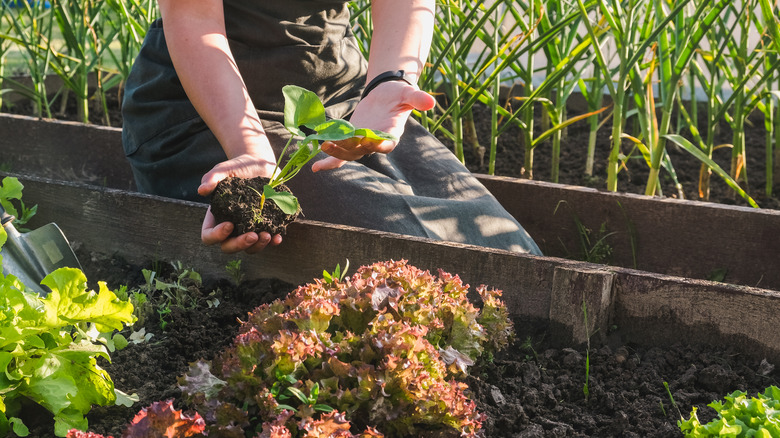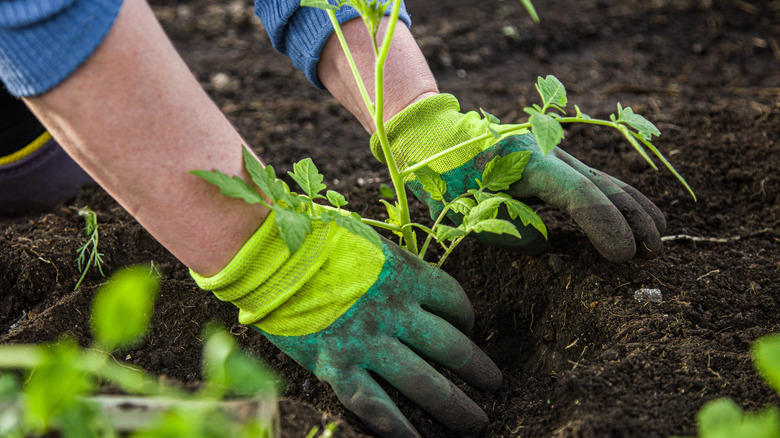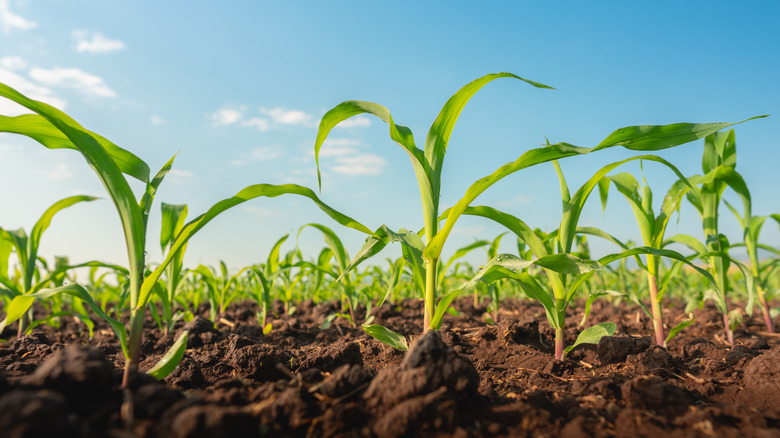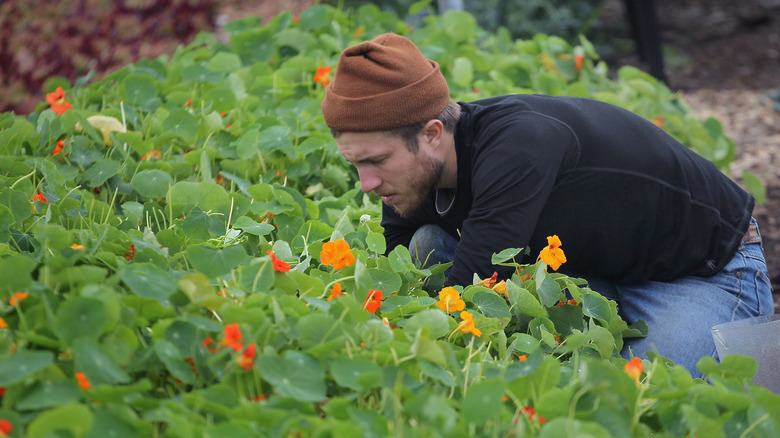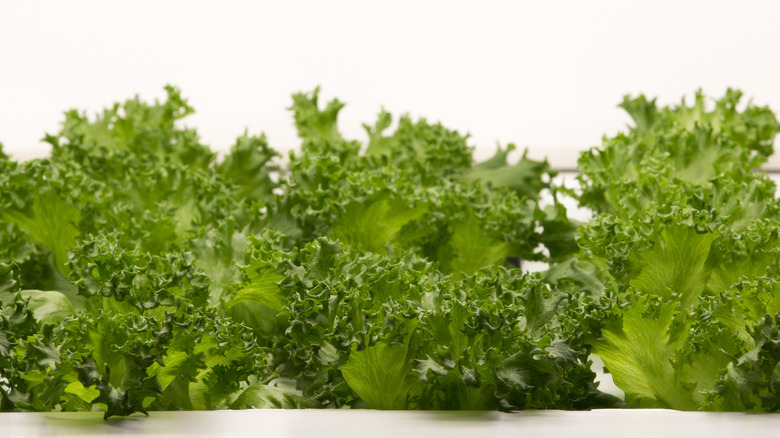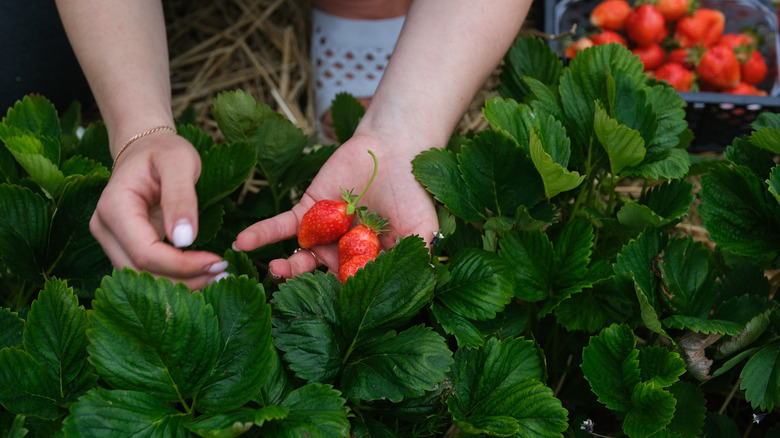5 Pairs Of Companion Plants That You Should Grow Together
There are many benefits to companion planting in your garden. Adding aromatic blooms and herbs as companion plants helps confuse and deter pests, protecting your hard work from damage. Companion planting also helps make the most of your garden space by pairing plants of different sizes — thoughtful planning helps you fit two crops in an area for one. Shorter plants like some herbs and flowers help prevent weeds by acting as a ground cover, which also helps keep water from evaporating from the soil's surface. This kind of ground cover works like mulch to keep the soil moist but is a more efficient use of space. According to Heeman's, taller, hardier plants can also help protect smaller, more fragile varieties from harsh wind and sun conditions.
Companion planting even makes your garden prettier. The combination of different heights, leaf shapes, and colorful blooms creates a beautiful space to spend your time. The key to companion planting is to choose the best pairings. For example, two large, nutrient-demanding plants like tomatoes and corn would not work well as companions, but they each have an ideal partner to make the most of your garden.
1. Tomatoes and basil
Tomatoes and basil are natural companions in the kitchen, but they are also wonderful companion plants in the garden. According to Mother Earth News, basil is a good companion for many plants but is particularly beneficial to tomatoes because it enhances the flavor of the fruit. The powerful scent of basil also helps deter common tomato pests, including whiteflies and the dreaded tomato hornworm, states Today's Homeowner. Basil anywhere in the garden also helps naturally repel mosquitoes.
You can combine any variety of basil with any tomato, so choose the cultivars you most prefer to eat. To add even more color and beauty to your garden, consider planting a yellow tomato, like sun gold cherry tomatoes, with purple basil. You'll still get all the beauty and flavor of tomatoes and basil, but this combination is pure garden art. When left to bloom, basil attracts many beneficial insects, making a lovely and aromatic cut flower for arrangements.
2. Corn and pole beans
The growth habits of corn and pole beans make them perfect companions in large or small gardens. Corn grows tall and strong, while pole beans need a trellis or something to climb on. By planting pole beans and corn together, you are making the most of your space with these cooperative plants — two crops in the area of one! Not only do beans and corn work well together because of how they grow, but beans are nitrogen-fixing, which means they can absorb nitrogen from the air and make it available in the soil, according to GrowVeg. Since corn uses a lot of nutrients to grow, especially nitrogen, this pairing is exceptionally beneficial.
To grow corn and pole beans as companions, start by planting your corn after the danger of frost has passed. Once the corn is about 12 inches tall, plant three bean seeds about 8 inches from the base of the plant. When the vines are long enough, wrap them around the cornstalk and let them grow together.
3. Cabbage and nasturtiums
Cabbage is a cold-tolerant crop considered a staple for many gardeners. Although cabbage is generally considered a low-maintenance garden plant, it can get infested with various bugs. When paired with the multi-purpose nasturtium, cabbage growers can expect fewer pests like aphids and beetles, states Burpee. Nasturtiums are a beautiful and beneficial plant in the garden. They attract bad bugs, keeping them away from your garden plants, but also feed valuable insects, including bees and hummingbirds, according to Ecrotek.
Everyone can benefit from the tasty blooms of this unique plant. In fact, every part of nasturtiums is edible, including the leaves, flowers, and seedpods. So, not only do nasturtiums protect your crops, they are a unique, beautiful, and tasty addition to fresh salads. Nasturtiums come in a wide variety of colors with two types of growing habits: bush and trailing. Select a bush variety to complement your cabbage. You can place them between cabbage plants or create a border of nasturtiums around the edge of your cabbage crop. To make this part of your garden stunning, consider planting multiple colors of nasturtiums in a bed of red cabbage.
4. Onions and lettuce
It's no surprise that the strong smell of onions is a deterrent for garden pests, making it a good companion for many crops. For small spaces, onions and lettuce are beneficial companions. While the scent of onions repels aphids, their compact growing habit means you can grow more food in a small space, according to Plants Spark Joy.
There are a couple of ways to grow lettuce and onions together. Since onions can be planted as soon as the soil has thawed, you can start them early, placing young bulbs about 6 inches apart. As you harvest onions for use in the kitchen, use that empty spot for a lettuce seedling. This process allows onions to protect lettuce from pests from the moment they are planted. Another option is to plant onions and lettuce simultaneously, with one onion bulb between each lettuce seedling. The distance between lettuce seedlings varies based on the species, but Gilmour recommends 4 inches apart for leafy sorts and up to 8 inches apart for butterhead lettuce.
5. Strawberries and thyme
Strawberries are highly susceptible to pests, so Home for the Harvest suggests using thyme as a companion plant. The scent of thyme repels whiteflies, damaging worms, and mosquitoes while attracting bees and other beneficial insects when it is in bloom. Thyme grows as a dense ground cover, which helps keeps the soil moist – the ideal growing conditions for strawberries. As a ground cover, thyme also smothers out weeds, which compete with strawberries for nutrients in the soil, resulting in fewer and smaller berries.
To plant thyme and strawberries as companions, use the row method. Place your strawberry plants about 12 inches apart in rows about 36 inches apart to allow the strawberry runners room to grow — plant thyme in the space between your strawberry rows. Since strawberries and thyme are perennials, they will need yearly maintenance. And as time passes, the bed will fill in with new thyme and strawberry plants. To keep your plants healthy and producing, remove the oldest strawberry and thyme plants as needed to make room for new growth.
